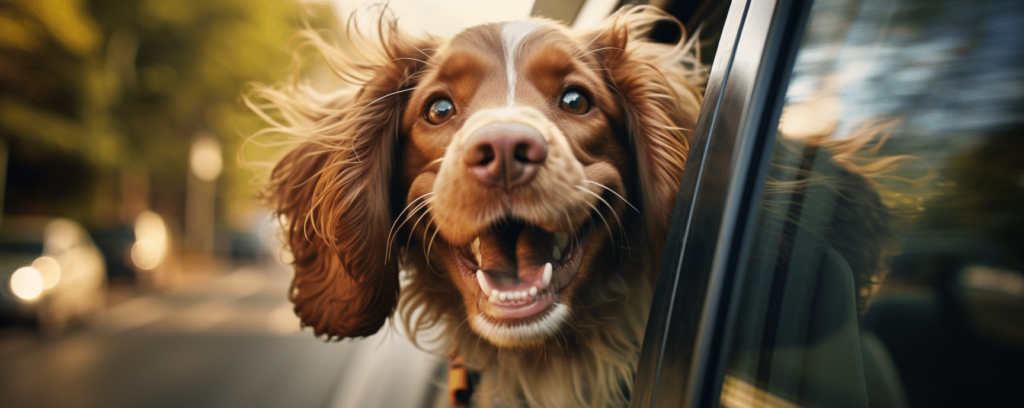Riding with Rover: Do Ubers Allow Dogs for a Pet-Friendly Journey?
Last updated Monday, April 8th, 2024

Do Ubers allow dogs on board? Yes, with Uber Pet, you can take your dog along for an additional fee, but final approval rests with your driver. Discover the ins and outs of Uber’s pet policy, potential costs, and essential advice for a stress-free trip with your furry companion in our comprehensive guide.
Key Takeaways
- Uber offers a specific pet-friendly travel option called Uber Pet, subject to additional fees and driver discretion, whereas Lyft leaves the decision to the driver’s preference, advising riders to communicate with their driver in advance.
- Service animals are legally protected and must be accommodated by rideshare drivers without extra charges, while emotional support animals lack the same protections and may face inconsistent experiences.
- Pet owners are responsible for any damages or cleaning charges incurred during rideshare trips and are advised to take preventive measures such as using carriers or seat belts, and maintaining communication with the driver to ensure a smooth ride.
Understanding Uber’s Pet Policy
Uber has recognized the need for pet-friendly travel options and has introduced a service specifically designed for this purpose. The Uber Pet option is a welcome development for many pet owners, making it easier to travel with their pets. However, it’s essential to know that Uber drivers also have a say in this matter.
Uber Pet: A Solution for Dog Owners
Uber Pet is a specialized service for riders with pets. Rather than leaving it up to chance, riders can select this option when booking their ride. However, this service comes with an extra fee, which ranges from $3 to $5 above the standard UberX fare.
While Uber Pet is primarily suitable for cats and dogs, riders can contact drivers in advance if they have more exotic pets. It’s important to note that riders are responsible for any cleaning charges that may arise from their pet’s hair, waste, or any damage caused in the vehicle during the trip.
Driver Discretion
Even with the Uber Pet option selected, drivers still have the right to refuse any animal they’re uncomfortable with. This highlights the importance of communicating with your driver in advance about your pet. If a driver opts not to have a dog in their car, they can cancel the trip.
Uber allows drivers to customize their experience with respect to pets. Drivers can opt in or out of Uber Pet trip requests through the app’s driving preferences. If a driver declines to transport a dog during an UberX ride, they may suggest supplying an alternate user by having the rider cancel and select an Uber Pet ride instead.
Navigating Lyft’s Stance on Pets
Unlike Uber, Lyft has a more flexible approach to pets. The company leaves the decision to the driver, rather than having a specific pet policy. This means that the acceptance of pets in a Lyft vehicle largely depends on each individual driver’s comfort and preference.
Lyft’s Approach to Pets
Lyft’s policy is accommodating towards non-service animals, but the decision ultimately lies with the driver. Since Lyft gives its drivers the power to decide on allowing pets in their vehicle, riders are advised to contact their driver in advance to ensure a pet-friendly journey.
Comparing Uber and Lyft
When comparing Uber and Lyft’s pet policies, there are some noticeable differences. Uber Pet rides are primarily designed for dogs and cats, but drivers have the discretion to accommodate other types of pets. On the other hand, Lyft leaves the decision entirely up to the driver, offering a more flexible approach.
The Uber Pet option is designed for one pet accompanied by a maximum of two riders. However, drivers may permit additional riders. Lyft, on the other hand, does not have a specific policy on the number of pets or riders, leaving it to the discretion of the driver.
Service Animals vs. Emotional Support Animals in Rideshares
When it comes to animals in rideshares, it’s important to differentiate between service animals and emotional support animals. According to the Americans with Disabilities Act (ADA), service animals are dogs that are trained to do work or perform tasks for people with disabilities. These animals are protected under the law, meaning rideshare drivers are required to accommodate them.
On the other hand, emotional support animals provide comfort through companionship but are not trained to perform specific tasks. As a result, they do not receive the same ADA protections as service animals, and rideshare drivers are not legally required to accommodate them.
Legally Required Accommodations
Both Uber and Lyft drivers are required by state and federal laws, including the ADA, to accommodate service animals without imposing additional fees. This means that riders with service animals using Uber are not required to use Uber Pet and are exempt from paying extra fees.
Uber takes these legal requirements seriously. Drivers who fail to abide by the legal requirements and company policy regarding service animals risk losing access to the Uber Driver app. If you encounter any issues, please file a ticket. Uber even has a specialized support team dedicated to service animal-related incidents, ensuring complaints are investigated and resolved, including refunding any wrongful cancellation charges.
Emotional Support Animals: No Guarantees
While emotional support animals play an essential role in many people’s lives, they do not have the same protections as service animals under the ADA. This means that rideshare companies like Uber and Lyft are not legally required to accommodate them.
As such, riders with emotional support animals may encounter challenges like being denied service by drivers. Due to the lack of legal requirements to accommodate emotional support animals, riders may face inconsistent experiences based on the discretion of each individual rideshare driver.
Preparing Your Pooch for a Rideshare Trip
Preparing your pet for a rideshare trip is crucial to ensure a smooth ride. As a rider, you are responsible for any cleaning charges that might result from your pet during the rideshare. The fees are assessed according to the extent of damage. Therefore, taking measures to prepare your pet and managing them during the ride can save you from unnecessary charges.
Communication with the Driver
Communication is key when planning to bring your pet on a rideshare. After booking the ride, it’s recommended to call your Lyft driver to confirm the possibility of bringing a pet along. This is not just courtesy; some drivers may have allergies or specific preferences regarding pets. When contacting us please include this information to ensure a smooth ride for both you and your pet.
Giving your driver a heads-up allows them to prepare the vehicle for the pet, potentially laying down seat covers for cleaning up easily after the ride. As a rider, it’s your responsibility to manage your pet during the journey, ensuring that any mess is swiftly addressed.
Doggy Etiquette
Ensuring that your pet behaves well during the ride is essential. As a rider, you should control your pet during the trip to protect them. Use a leash, harness, pet carrier, or a seat belt harness to secure them while riding.
Beyond securing your pet, make sure they’re comfortable during the ride. You can provide toys and ensure they have their own space. Keep the car temperature cool when necessary. Remember, safety comes first; always keep your dog inside the vehicle and prevent them from hanging their head out of the window.
Public Transportation and Pets
Beyond rideshares, knowing the pet policies of public transportation systems can come in handy. Policies vary widely, with some systems requiring pets to be in carriers, while others may allow them to be leashed. Please register or sign in to access detailed information about pet policies on various transportation systems and submit a request if needed.
For instance, Amtrak allows pets on trains with certain conditions such as a 20-pound weight limit including the carrier, a fee, and restrictions on the number of pets per passenger.
Transit Policies Vary
Transit policies for pets vary significantly between cities and transportation systems. For instance, in New York City, pets must be enclosed in a container to board the subway or use public transportation. On the other hand, San Francisco’s BART allows small dogs in carriers and mandates that larger dogs be leashed and muzzled.
In Seattle, the transit system doesn’t require carriers for dogs. However, they must be leashed, and larger dogs are subject to the standard human fare when boarding. This highlights the regional variations in pet policies, necessitating pet owners to be aware of the rules in their specific location.
Tips for a Smooth Public Transit Experience with Your Dog
When using public transportation, be prepared with the proper equipment like a hard carrier or muzzle as required by the transport system. Keep your dog on a leash at all times during transit, and evaluate whether they need to be muzzled in accordance with specific public transport system rules.
Always ensure that your dog does not occupy seats or block the aisle. Keeping them on the floor throughout the journey on public transport makes the journey comfortable for other passengers and ensures a smooth ride for your pet. It’s important to teach your dog to sit calmly during the trip.
Frequently Asked Questions
Does Uber still do pets?
Yes, Uber still allows pets in their vehicles, but it’s up to the driver’s discretion. Additionally, service dogs are legally obligated to be accepted.
Is Uber pet more expensive?
Yes, Uber Pet has an additional fee of $3 to $5, but it’s still an affordable option for passengers seeking a pet-friendly ride, and it ensures they will be matched with a driver who is comfortable with pets.
How do I turn on Uber pet?
To turn on Uber Pet, simply use the Uber app and scroll through vehicle options until you find the pet-friendly feature. This will enable you to start receiving Uber Pet trips.
What is Lyft's policy for pets?
Lyft drivers have the discretion to decide if pets are allowed in their vehicles, as there isn’t a specific pet policy in place. This information was accurate as of today.











